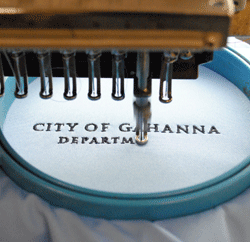The History of Embroidery
Sharon Santino,
Jun 20, 2012
 Embroidery, the art of decorating fabric or other materials by stitching designs using thread or yarn, is an important part of the promotional products and apparel business. You've seen how we embroider in-house and have learned about the helpfulness of sew-outs, but do you know the history of embroidery itself?
Embroidery, the art of decorating fabric or other materials by stitching designs using thread or yarn, is an important part of the promotional products and apparel business. You've seen how we embroider in-house and have learned about the helpfulness of sew-outs, but do you know the history of embroidery itself?
The Beginning of Embroidery
The exact origins and the beginning of embroidery are unknown, but examples survive from ancient China, Egypt and Northern Europe. In addition to string, materials such as jewels, stones, beads and bones* have been used to embellish fabric.
Embroidery was first done by hand, a laborious and time-consuming task, but, as evidenced by objects such as the Bayeux Tapestry, the results are astounding. Since hand-sewn embroidery took so much time, it used to be considered a symbol of wealth, as only the rich could afford it.
The Industrial Revolution and Embroidery
The embroidery industry was revolutionized in 1828, when Joshua Heilmann from Mulhouse improved the design of a hand embroidery machine. This began a chain of events ultimately leading to the development hand-powered embroidery looms in the late 19th century. Soon, many more machines were manufactured and by the beginning of the 20th century, the availability of embroidery on clothing and fabric greatly expanded, driving prices down and the amount of products up.
Embroidery in the 21st Century
Today, thanks to computerized, multi-head embroidery machines, designs that were once hand-sewn can be mass-produced. Artwork can easily be "digitized" (scanned and turned into a set of points that tell the computer how to stitch the design), uploaded to an embroidery machine and used to add logos, monograms and other patterns to everything from decorative household items to embroidered blankets and promotional apparel.
*We only use thread at Leaderpromos, but our manufacturers can embellish your apparel with beads, sequins and more - but alas, no bone. Sorry!


